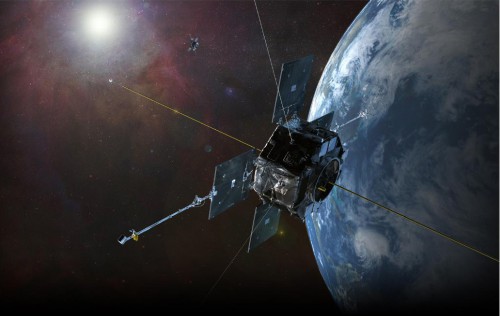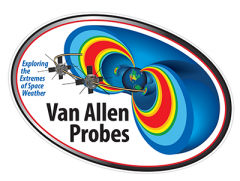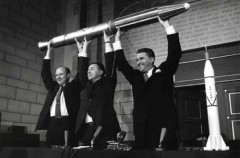
Six months after their launch from Cape Canaveral Air Force Station, Fla., NASA’s twin Van Allen Probes have discovered a third radiation belt girdling the Earth. Published by the journal Science, the discovery alters scientists’ perception of the structures and processes of these belts, which were first identified by a team led by University of Iowa physicist Dr. James Van Allen in 1958. Previous thinking posited that two distinct regions of trapped radiation—extending from 620 miles to more than 37,200 miles above the surface—existed. Their impact upon humanity is truly profound, since they can swell dramatically—according to solar storms and space weather—potentially endangering communications and other satellites, as well as astronauts and cosmonauts. The new belt was formed and destroyed by a powerful interplanetary shockwave and exerted only a temporary presence, enduring for just a few weeks.
The discovery was made through observations by the Relativistic Electron Proton Telescope (REPT) instrument aboard the Probes, which revealed the presence of three distinct, long-lasting belt structures, with the emergence of a second, empty “slot” region between them. “This is the first time we have had such high-resolution instruments look at time, space, and energy together in the outer belt,” explained Daniel Baker, REPT instrument lead at the Laboratory for Atmospheric and Space Physics at the University of Colorado at Boulder. “Previous observations of the outer radiation belt only resolved it as a single blurry element. When we turned REPT on, just two days after launch, a powerful electron acceleration event was already in progress, and we clearly saw the new belt and new slot between it and the outer belt.”
It was so unexpected that, at first, Baker thought he was seeing a problem with the instrument. By the fifth day of REPT operations, investigators were able to plot their observations and watch the formation of the new belt for four weeks in September 2012. It is believed that a huge solar prominence, which erupted from the Sun on 31 August, may have been a contributory factor in the creation of the short-lived belt. At length, on 1 October, another interplanetary shockwave, more powerful than the previous one, obliterated both the outer and middle rings. “This left only the inner Van Allen belt intact,” explained Ron Cowen on the website Nature.com, citing Baker. “Seven or eight days later, a third shockwave somehow restored the original structure of the two belts as depicted in textbooks.” By 9 October, added Baker, “the whole outer belt was lit up again … but with the [middle] ring gone.” It is thought that solar outbursts such as this will become more common as the Sun approaches the peak of its 11-year activity cycle.

Launched on 30 August 2012, aboard United Launch Alliance’s Atlas V 401 rocket from Cape Canaveral Air Force Station, Fla., the radiation-hardened Van Allen Probes—previously known as the Radiation Belt Storm Probes (RBSP)—will examine the structures and dynamics of this mysterious environment for at least two years. The project is part of the “Living With a Star” program, managed by NASA’s Goddard Space Flight Center of Greenbelt, Md., and seeks to discover the processes responsible for accelerating and transporting particles in the Van Allen belts to understand and quantify the loss of electrons, to determine the balance between electron acceleration and their loss, and to cast new light upon how the region changes during geomagnetic storm events. As part of the mission, the Probes will work in conjunction with NASA’s Balloon Array for RBSP Relativistic Electron Losses (BARREL), which envisages the launch of 20 high-altitude balloons, each measuring 90 feet in diameter, from Antarctica in a pair of campaigns in 2013-14.
The Van Allen belts are named in honor of James Van Allen (1914-2006), who gained public awareness when his proposal to include a Geiger counter aboard several early Explorer missions to detect charged particles paid off in spectacular style. Born and raised in Iowa, he received his undergraduate, master’s, and doctoral degrees, all in physics, and all from the University of Iowa. His interest in cosmic rays arose in the early 1940s, whilst working on proximity fuses for bombs, rockets, and projectiles at the Carnegie Institution in Washington, D.C., and at Johns Hopkins University’s Applied Physics Laboratory in Baltimore, Md. After World War II, he settled into an academic career at Johns Hopkins, working on high-altitude balloon and early sounding rocket programs. He later returned to the University of Iowa to teach and lead research in upper atmospheric physics.

It was in 1958, during the International Geophysical Year, that Van Allen’s fame skyrocketed, both figuratively and literally, to its greatest heights. On 31 January, the United States delivered its first artificial satellite, Explorer 1, into orbit, carrying a micrometeorite detector and cosmic-ray instrument fabricated by Van Allen and his graduate students. A similar payload was installed aboard Explorer 2, whose launch vehicle failed on 5 March, but Explorer 3 picked up the baton with a perfect ascent on 26 March. The results from the two missions identified a donut-shaped region of charged particles trapped by Earth’s magnetic field. When Pioneer 3 entered space in December 1958, it provided additional data which led to the identification of a second radiation belt.
These belts lie within the Earth’s inner magnetosphere, extending from 600 miles to more than 37,200 miles above the surface, and are thought to be filled with highly energetic solar wind and cosmic ray particles. The “inner” belt extends from 4,700 miles to 11,850 miles above Earth and contains high concentrations of electrons and energetic protons, trapped by strong regional magnetic fields. Due to the slight offset of the belts from our planet’s geometric center, the inner belt makes its closest approach to the surface—just 125 miles or so—at the “South Atlantic Anomaly.” This poses a particular hazard for Earth-orbiting satellites, whose sensitive electronics must be shielded to support extended mission durations. Meanwhile, the far larger “outer” belt is populated by highly energetic protons, alpha particles, and oxygen ions, whose flux varies wildly, according to magnetic-field and plasma disturbances induced by the Sun.
The threat posed to space missions—particularly with humans—is so real that radiation shielding will become mandatory for NASA’s proposed Beyond Earth Orbit (BEO) aspirations. The nine lunar-voyaging Apollo crews, launched between December 1968 and December 1972, experienced a relatively low exposure to their radiation, thanks to the short period of time spent flying through the belts. One of the primary legacies of the Van Allen Probes will be the development of a clearer understanding of the structure and dynamics of this mysterious region, high in the Home Planet’s magnetic realm. “Even 55 years after their discovery, the Earth’s radiation belts still are capable of surprising us,” said Nicky Fox, deputy project scientist for the mission at the Johns Hopkins University Applied Physics Laboratory in Laurel, Md. “We thought we knew the radiation belts, but we don’t. The advances in technology and detection … have an almost immediate impact on basic science.”




One Comment
One Ping
Pingback:பூமியைச் சுற்றி மூன்றாம் “வான் ஆலன்” கதிர்வீச்சு மின்துகள் வளையம் [Van Allen Radiation Belt] தோன்றி மறைந்த